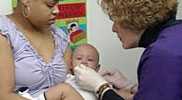-
About Rotavirus
Describes symptoms of rotavirus disease, how it spreads, treatment... -
Vaccination
Provides information about rotavirus vaccines... -
Clinical Information
Overview of clinical features, the virus, diagnosis, treatment and prevention... -
Rotavirus in the U.S.
Information about rotavirus burden, impact, seasonality and risk factors as well as link to CDC surveillance systems that monitor rotavirus... -
Textbooks and Publications
Lists selected scientific articles, chapters from CDC manuals... -
Multimedia
Web feature, App, podcasts, and videos...
Want to Know More About Rotavirus?
Download CDC’s mobile app now!
Click “Disease of the Week,” find rotavirus, and take the quiz to test your knowledge!
Available on iOS, Android and Windows 8 tablets
Rotavirus is a contagious virus that can cause gastroenteritis (inflammation of the stomach and intestines). Symptoms include severe watery diarrhea, often with vomiting, fever, and abdominal pain. Infants and young children are most likely to get rotavirus disease. They can become severely dehydrated and need to be hospitalized and can even die.
Vaccination
Rotavirus vaccines are very effective at preventing rotavirus disease. Children should get either of the two available rotavirus vaccines:
- RotaTeq® (RV5) is given in 3 doses at ages 2 months, 4 months, and 6 months
- Rotarix® (RV1) is given in 2 doses at ages 2 months and 4 months.
How Rotavirus Spreads
People who are infected with rotavirus shed the virus in their feces (poop). If you accidently get poop in your mouth, you can get infected with rotavirus. This can happen by
- having contact with someone who is infected with rotavirus
- touching contaminated objects or surfaces then putting your fingers in your mouth
- consuming contaminated food and liquids
en Español
- Page last reviewed: August 12, 2016
- Page last updated: August 12, 2016
- Content source:


 ShareCompartir
ShareCompartir


